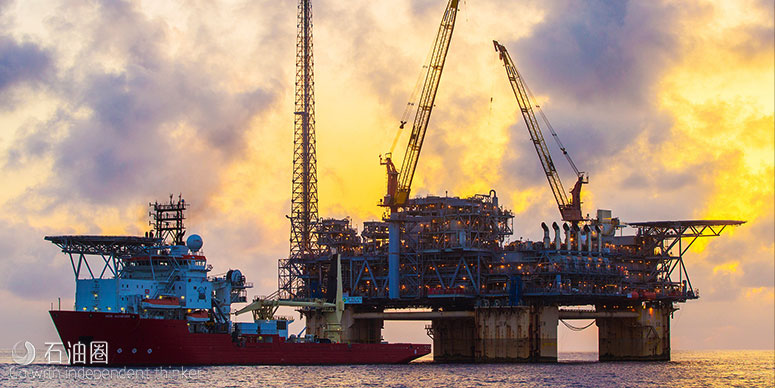Customized riser installation enhances safety, efficiency for multi-well deepwater projectb
The risks, costs, and technical complexities of deepwater development often require customized solutions that assure safety and boost field economics by employing life-of-well systems. All aspects of well construction, including rig design, riser installation, pipe-handling and connection makeup and integrity, must be implemented with a level of precision and service quality that will enable the wells to produce safely for 30 or more years.
For a multi-well deepwater project in Southeast Asia, a major operator engineered a unique tension-leg platform (TLP) with 24 slots for eventual batch drilling. The vertically moored floating platform moves laterally with changing weather and ocean conditions, and is well suited for the project’s 1,640-ft (500-m) water depth. TLPs typically use a top-tension riser (TTR) that runs between the platform and seabed. The riser is securely connected to the wellhead with an external tieback connector and remains in place for the life of the well.
For this project, the operator deployed a specially designed TTR that could be used for both drilling and production. Unlike conventional systems that use separate risers for drilling and production, the single-casing combination (SCC) TTR uses the same outer riser for drilling, completion, production, and workover operations. This approach enables the operator to eliminate the time and cost of installing two sets of risers, and streamlines drilling.
In a first-of-its-kind installation, Weatherford engineered a fit-for-purpose tubular handling and makeup package for the multi-use riser. The integrated, customized solution, which was designed for use on 11 platform wells, combines several tubular running technologies and tools that are specially designed to handle non-API sizes of pipe. As a whole, the package is able to transport the 40-ft (12-m) long TTR joints from the rig floor; monitor and evaluate torque data for safe, efficient makeup and breakout of the 40 high-delta torque connections required for each well; and run the pipe inside the rotary table – all with the least possible disruption to the existing rig equipment.
Deploying a highly robust, mechanized riser power tong onto the rig was essential to enable safe and efficient makeup and breakout of hightorque connections that far exceed the standard 100,000 ft-lbs of torque provided by conventional power tongs. Weatherford’s global and regional engineering teams collaborated closely with the operator for more than a year to ensure that the riser installation met or exceeded the highest industry standards. In preparation for the initial riser installation on the first platform well in October 2016, a qualification test in August 2015 demonstrated that the system could reliably achieve the required delta torque connections.
High-torque connections
The cornerstone technology of the ongoing riser installation project is the Weatherford 21- 300 riser tong, designed specifically to handle delta torque connections as well as to provide continuous rotation throughout the makeup cycle. For the initial job, final makeup torques reached as high as 110,000 ft-lbs, and final breakout torques reached up to 235,000 ft-lbs. While most operations do not require these high levels of torque, the 21-300 riser tong is capable of meeting such rare client challenges, especially in the Eastern Hemisphere.
The 7-ton mechanized tong can produce up to 300,000 ft-lbs of continuous rotational torque during both the makeup and breakout processes – considerably higher than what conventional systems provide. It can be used in any riser installation, handling sizes ranging from a 9-in. to 21-in. OD. In this specific application, the tong was configured according to the acceptance criteria for the non-standard 18.149-in. OD delta torque connection.
Rig-up of the tong can be completed using conventional procedures without modifications to the rig. The tong is also capable of both fully mechanized remote operations and semi-mechanized operations. The three-motor design distributes force evenly around the gear ring, improving gripping effectiveness to decrease the risk of pipe damage.
A hydraulic, three-jaw gripping system provides extremely high torque capability and distributed gripping forces over a large area, which reduces the potential for connection damage. Most importantly for long-term wellbore integrity, the tong is compatible with torque monitoring, control and analysis hardware and software, which enables automated recording of delta turns and torque.
To precisely position the heavy riser tong, another robust mechanized system comes into play. The PowerFrame II tong-positioning system is remotely operated to eliminate the need for manual handling by the crew, thereby enhancing safety and reducing operating costs. The tongpositioning system uses wheels for horizontal movement on the rails and two hydraulic lift cylinders for vertical lifting of the gantry. With a maximum lifting stroke of 77 in., the system accelerates the lifting and positioning process.
The plug-and-play design of the system enables quick and efficient tong change-out, further reducing time and cost. The system is track-mounted and uses programmable logic control technology to move a full range of Weatherford power tongs from a standby position on the rig floor to the well center.

 石油圈
石油圈
